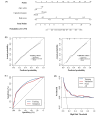Ultrasound radiomics signature for predicting central lymph node metastasis in clinically node-negative papillary thyroid microcarcinoma
- PMID: 38369523
- PMCID: PMC10875890
- DOI: 10.1186/s13044-024-00191-x
Ultrasound radiomics signature for predicting central lymph node metastasis in clinically node-negative papillary thyroid microcarcinoma
Abstract
Background: Whether prophylactic central lymph node dissection is necessary for patients with clinically node-negative (cN0) papillary thyroid microcarcinoma (PTMC) remains controversial. Herein, we aimed to establish an ultrasound (US) radiomics (Rad) score for assessing the probability of central lymph node metastasis (CLNM) in such patients.
Methods: 480 patients (327 in the training cohort, 153 in the validation cohort) who underwent thyroid surgery for cN0 PTMC at two institutions between January 2018 and December 2020 were included. Radiomics features were extracted from the US images. Least absolute shrinkage and selection operator logistic regression were utilized to generate a Rad score. A nomogram consisting of the Rad score and clinical factors was then constructed for the training cohort. Both cohorts assessed model performance using discrimination, calibration, and clinical usefulness.
Results: Based on the six most valuable radiomics features, the Rad score was calculated for each patient. A multivariate analysis revealed that a higher Rad score (P < 0.001), younger age (P = 0.006), and presence of capsule invasion (P = 0.030) were independently associated with CLNM. A nomogram integrating these three factors demonstrated good calibration and promising clinical utility in the training and validation cohorts. The nomogram yielded areas under the curve of 0.795 (95% confidence interval [CI], 0.745-0.846) and 0.774 (95% CI, 0.696-0.852) in the training and validation cohorts, respectively.
Conclusions: The radiomics nomogram may be a clinically useful tool for the individual prediction of CLNM in patients with cN0 PTMC.
Keywords: Central lymph node metastasis; Machine learning; Nomogram; Papillary thyroid microcarcinoma; Radiomics.
© 2024. The Author(s).
Conflict of interest statement
There are no conflicts of interest or financial ties to disclose from any of authors.
The authors declare no competing interests.
Figures



Similar articles
-
A nomogram based on ultrasound radiomics for predicting the invasiveness of cN0 single papillary thyroid microcarcinoma.Gland Surg. 2023 Dec 26;12(12):1735-1745. doi: 10.21037/gs-23-473. Epub 2023 Dec 22. Gland Surg. 2023. PMID: 38229850 Free PMC article.
-
Development and Validation of a Computed Tomography-Based Radiomics Nomogram for the Preoperative Prediction of Central Lymph Node Metastasis in Papillary Thyroid Microcarcinoma.Acad Radiol. 2024 May;31(5):1805-1817. doi: 10.1016/j.acra.2023.11.030. Epub 2023 Dec 9. Acad Radiol. 2024. PMID: 38071100
-
A Nomogram Based on Clinicopathological and Ultrasound Imaging Characteristics for Predicting Cervical Lymph Node Metastasis in cN0 Unilateral Papillary Thyroid Microcarcinoma.Front Surg. 2021 Dec 3;8:742328. doi: 10.3389/fsurg.2021.742328. eCollection 2021. Front Surg. 2021. PMID: 34926565 Free PMC article.
-
Clinicopathologic predictors of central lymph node metastases in clinical node-negative papillary thyroid microcarcinoma: a systematic review and meta-analysis.World J Surg Oncol. 2022 Apr 1;20(1):106. doi: 10.1186/s12957-022-02573-7. World J Surg Oncol. 2022. PMID: 35365171 Free PMC article.
-
The incidence and risk factors for central lymph node metastasis in cN0 papillary thyroid microcarcinoma: a meta-analysis.Eur Arch Otorhinolaryngol. 2017 Mar;274(3):1327-1338. doi: 10.1007/s00405-016-4302-0. Epub 2016 Sep 19. Eur Arch Otorhinolaryngol. 2017. PMID: 27645473 Review.
References
LinkOut - more resources
Full Text Sources

